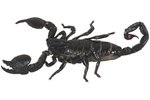If you live in a place crawling with salamanders, you're aware they make tempting toys for your cat. It's easy to see the attraction. These slick little dudes dart here and there, fast as lightning, taunting Boots with their zippy movements. If she catches the wrong one, expect trouble.
Newts Are Salamanders
Salamanders are a group of amphibians that have tails as adults and include newts, which spend most of their time on land. Newts have very short legs -- so short that their bellies touch the ground. They tend to be active during night hours and dine on worms, spiders and insects. Though these guys may look like they have dry, crinkled skin, they need to stay moist; if they get too hot and dry, they'll die. That's why you're more likely to find them in forested areas.
Western Newts
If home is on the West Coast, Boots has a few creatures to be wary of. The California newt grows to about 8 inches long and sports an orange-brown color. He tends to hang out around logs and rock crevices. The smaller red belly newt maxes out at about 3.5 inches, and has a dark top and a tomato-colored belly. The rough-skinned newt, technically known as the taricha granulosa, can get as long as 8 inches and has light-brown to dark-brown dry, warty skin. If Boots decides any of these three guys would make a tasty snack, she'd likely regret it, particularly if she takes on the rough-skinned newt, the most poisonous of the three species. In fact, this nasty guy is the most toxic newt in North America.
Eastern Newt
The east coast has its share of salamanders to beware of as well. There are four subspecies to watch out for: the red-spotted newt, the central newt, the broken-striped newt and the peninsula newt. They tend to range between 2.5 and 3.5 inches in length. They inhabit the northeastern United States to the Gulf Coast and Florida. Though not as toxic as their westward cousins, all four subspecies give off toxic secretions to ward off predators, including Boots.
Salamander Poisoning
If Boots catches a toxic salamander, chances are she'll spit it out pretty quickly. Salamanders use their toxic secretions as protection against predators. In the event she decided to have one of these guys for lunch, her reaction will depend on which kind she had for a snack. She may slobber, paw at her mouth, vomit or have difficulty standing or walking. In extreme cases, she can become paralyzed, blind or even die, so it's important to get treatment for her right away. Rinse her mouth with copious amounts of water immediately -- you may have to use a sink hose or get her in the tub -- and then get her to the vet.
References
- Feline Medicine and Disease Managment; Animal Health Publications
- Cat Owner's Home Veterinary Handbook; Debra M. Eldredge et al.
- ReptileChannel.com: Eastern Newt Species Profile
- University of Wisconsin-Eau Claire: Toxic Animals Around the World: Western Newts
- San Diego Zoo: Amphibians: Salamander & Newt
- Exotic Animal Medicine for the Veterinary Technician; Bonnie Ballard and Ryan Cheek
- AmphibiaWeb: Taricha granulosa
- AmphibiaWeb: Taricha rivularis
Photo Credits
-
Hemera Technologies/AbleStock.com/Getty Images





